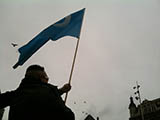Risky Business: Is the US Supporting Anti-Chinese Militants in Syria?
10 Oct 2016
By Christina Lin for Institut für Strategie- Politik- Sicherheits- und Wirtschaftsberatung (ISPSW)
This article was external pagepublishedcall_made by the external pageInstitute for Strategic, Political, Security and Economic Consultancy (ISPSW)call_made in October 2016.
Abstract
With war hawks in US, Turkey, Qatar and Saudi arming and funding anti-Chinese militants in Syria that are planning more attacks on Chinese embassies and interests abroad, coupled with US gunboat diplomacy in the South China Sea, this dangerous “deterring the dragon” combination risks turning into a “provoking the dragon” scenario, and may escalate into a military conflict between two nuclear powers.
On August 30, a Uyghur suicide bomber attacked the Chinese embassy in Kyrgyzstan. According to Bishkek’s GKNB security service, the terrorist attack was ordered by the Turkistan Islamic Party (TIP/ETIM) in Syria, financed by the re-branded al Nusra Jabhat Fatah al-Sham (JFS), coordinated from Turkey, and carried out by a TIP member.
The bombing demonstrates that despite vigorous cooperation between China and Central Asian states, Syria-based Chinese Uyghur militant groups, embedded in Idlib governorate, continue to successfully conduct operations and channel funds and people in the Eurasia space.
It also reveals how Syria’s Idlib has replaced AfPak’s Tora Bora/FATA as headquarter for global jihadi groups.
When TIP was mainly based in Pakistan’s federally administered tribal areas (FATA), the Chinese were already concerned about its close ties with al-Qaeda and increasing Chinese “Turkistan-iszation” of al-Qaeda. Indeed, TIP leader Abdul Haq al Turkistan was trained by al-Qaeda in FATA, and also appointed as a member of its majlis-e-shura or executive council in 2005.
He was later succeeded by Abdul Shakoor Turkistani, a Chinese Uyghur well known for his friendly terms with major Taliban groups in Waziristan.1 A few weeks before the death of Osama bin Laden, al-Qaeda appointed him as new commander of its Pakistan forces and training camps.
After the Syrian war broke out, TIP militants in AfPak began moving to Syria to wage jihad, along with an increasing stream of Uyghur refugees from Xinjiang in 2014 and 2015, many of whom were desperate and exploited by jihadist recruiters in Turkey’s Istanbul and Kayseri to fight in Syria and Iraq. Now TIP and al-Qaeda have largely moves their major operations from AfPak to Syria.2
Syria’s Idlib as the new Afghan Tora Bora for global jihad
In April 2015 TIP, Al Nusra, Ahrar al Sham and various Free Syrian Army factions colluded to form the Army of Conquest (Jaish al-Fatah) and took over Idlib governorate, where Al Nusra, regardless of its cosmetic name change, is now attempting to establish an Islamic emirate.3
According to Charles Lister, formerly at Brookings Doha Center with close ties to the Syrian opposition, the Idlib offensive had been planned for eight months to capture and transform it into the opposition core area of control, and was coordinated by the U.S.-led operations room in southern Turkey which encouraged “vetted groups” to more closely cooperate with Islamists in frontline operations.4 The US-led coalition also dramatically increased its level of assistance and provision of intelligence to the rebel opposition.
Several commanders of the Idlib operation also informed Lister that whereas previously these multinational operations rooms have demanded that recipients of military assistance cease direct coordination with groups like al-Nusra, the Idlib offensive was a game changer that actually prompted closer cooperation with the Conquest Army jihadi groups, due to pressures from Turkey, Saudi Arabia and Qatar.
This could help explain why in the recent ceasefire agreement, Secretary Kerry called for the Russian and Syrian air force to not bomb Al Nusra positions in Idlib and Aleppo. Indeed in 2015, General Petraeus also called for supporting al-Qaeda as an asset both against ISIS and against the Syrian army.5
As such, this may perhaps lend credence to a September 26 article in the German newspaper Kölner Stadtanzeiger, wherein an al Nusra commander confirmed American anti-tank TOW “missiles were given directly to us” and not through the Free Syrian Army. Being closely linked to Nusra, TIP has also shown footages of using US-TOW missiles in its battles in Syria.6
The Nusra commander said initially US lumped Al Nusra with IS, but now “the Americans are on our side” and assisting with “use of satellites, missiles, reconnaissance work, thermal surveillance cameras” to help overthrow the secular Syrian government, echoing Lister’s article in 2015 regarding US-led operations room increasing assistance and provision of intelligence to the Conquest Army.7

With US and its allied support, TIP, Nusra and Ahrar al Sham in the Conquest Army have proven to be effective fighters against the Syrian army in various offensives in Homs, Hama and Aleppo. In May 2016, they captured Kahn Touman in southern Aleppo.
Later videos emerged of US/UK-funded White Helmet members with two captured young Syrian soldiers in Kahn Touman, and taunting “Assad, Russia, Iran and China, are they stronger than god?” The two soldiers were later executed by TIP militants.8

With this type of evidence that US, Turkey, Saudis and Qataris are supporting and arming militants that will attack China and Russia, it likely forced the hand of Russia to enter the fray and support the Syrian government in October 2015, and now China in August 2016.
China beefs up its foreign security posture
In the face of western-inflamed Uyghur militancy now taking on a transnational nature, China is altering its foreign security posture and amending its non-interference policy. On August 14, China and Syria signed agreements to upgrade military ties, on the heels of the August 3 agreement for counter-terrorism cooperation between China, Afghanistan, Pakistan and Tajikistan. China already has military agreements with Afghanistan on equipping and training Afghan security forces on counter-terrorism, especially enlisting Kabul and Islamabad’s help to combat TIP and other al-Qaeda affiliates in AfPak post-NATO ISAF operation.
Beijing also harbors suspicions that US intention in Syria is not one of counter-terrorism, reinforced by US military writings. In a February 2014 article in the US Naval Institute’s Proceeding magazine entitled external page‘Deterring the Dragon’,call_made the author, a retired naval commander, proposed sending special operation forces to arm China’s restive minorities in Xinjiang and Tibet at a time when China is reeling from an uptick of domestic terrorists attacks ((Beijing 2013, Kunming and Urumqi 2014).9 The author also proposed laying offensive underwater mines along China’s coast to close China’s main ports and destroy its sea lines of communications.
Now with war hawks in US/Turkey/Qatar/Saudi arming and funding anti-Chinese militants in Syria that are planning more attacks on Chinese embassies and interests abroad, coupled with US gunboat diplomacy in the South China Sea, this dangerous “deterring the dragon” combination risks turning into a “provoking the dragon” scenario, and may escalate into a military conflict between two nuclear powers.
This article was first published by the Asia Times on September 28, 2016.
Notes
1) Jacob Zenn, “Al Qaeda’s Uyghur jihadi: A Profile of the Turkistan Islamic Party’s Abdul Shakoor Turkistani”, Militant Leadership Monitor, Vol. 2, Issue 12, December 30,
2) Eric Schmitt, “Al Qaeda Turns to Syria, With a Plan to Challenge ISIS”, New York Times, May 16, 2016, external pagehttp://www.nytimes.com/2016/05/16/world/middleeast/al-qaeda-turns-to-syria-with-a-plan-to-challenge-isis.html?_r=0call_made
3) Vice News, “Inside the Battle: Al Nusra-Al Qaeda in Syria”, November 11, 2015,
external pagehttps://www.youtube.com/watch?v=7sPY0X8SrLocall_made
4) Charles Lister, “Why Assad is losing”, Brookings Institution, May 5, 2015, external pagehttp://www.nytimes.com/2016/05/16/world/middleeast/al-qaeda-turns-to-syria-with-a-plan-to-challenge-isis.html?_r=0call_made
5) Shane Harris, Nancy C. Youssef, “Petraeus: Us Al Qaeda Fighters to Beat ISIS”, The Daily Beast, August 31, 2015, external pagehttp://www.thedailybeast.com/articles/2015/08/31/petraeus-use-al-qaeda-fighters-to-beat-isis.htmlcall_made ; Catherine Philp, “Petraeus: US must fund al-Qaeda”, The Times, September 3, 2015, external pagehttp://www.thetimes.co.uk/tto/news/world/middleeast/article4545775.ececall_made
6) Caleb Weiss, “Turkistan Islamic Party claims using US-made anti-tank missile in northwest Syria”, The Long War Journal, December 23, 2015, external pagehttp://www.longwarjournal.org/archives/2015/12/turkistan-islamic-party-claims-using-us-made-anti-tank-missile-in-northwest-syria.phpcall_made
7) Jurgen Todenhöfer: Interview with Al-Nusra Commander “The Americans stand on our side”, English translation September 26, 2016, external pagehttp://www.moonofalabama.org/2016/09/todenhöfer-interview-with-al-nusra-commander-the-americans-stand-on-our-side.htmlcall_made ; original German version: external pagehttp://www.ksta.de/politik/interview-mit-al-nusra-kommandeur–die-amerikaner-stehen-auf-unserer-seite–24802176call_made; Video of interview: external pagehttps://www.youtube.com/watch?v=8K6zqSTSp6gcall_made
8) external pagehttps://twitter.com/theLemniscat/status/779010281368346624call_made; external pagehttp://21stcenturywire.com/2016/06/21/who-are-the-syria-white-helmets/call_made
9) Commander Victor L. Vescovo, US Navy Reserve (Retired), “Deterring the Dragon…From (Under) the Sea”, Proceedings Magazine, US Naval Institute, February 2014, Vol. 140./2/1,332, external pagehttp://www.usni.org/magazines/proceedings/2014-02/deterring-dragon-under-seacall_made
About the Author
Dr Christina Lin is a Fellow at the Center for Transatlantic Relations at SAIS-Johns Hopkins University where she specializes in China-Middle East/Mediterranean relations, and a research consultant for Jane’s Chemical, Biological, Radiological, and Nuclear Intelligence Centre at IHS Jane’s. She is the author of "The New Silk Road: China's Energy Strategy in the Greater Middle East" (The Washington Institute for Near East Policy), and a former director for China policy at the U.S. Department of Defense.
For more information on issues and events that shape our world, please visit the CSS Blog Network or browse our Digital Library.

